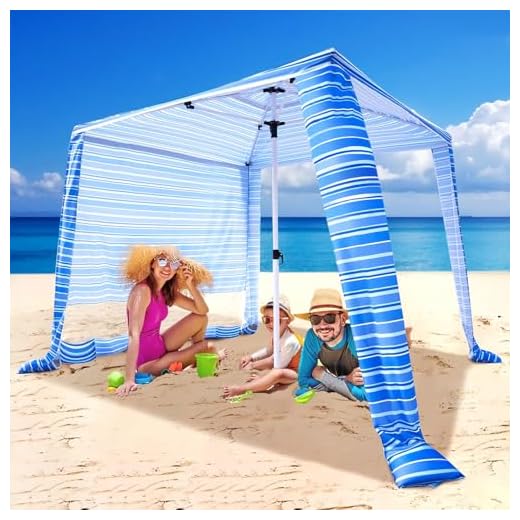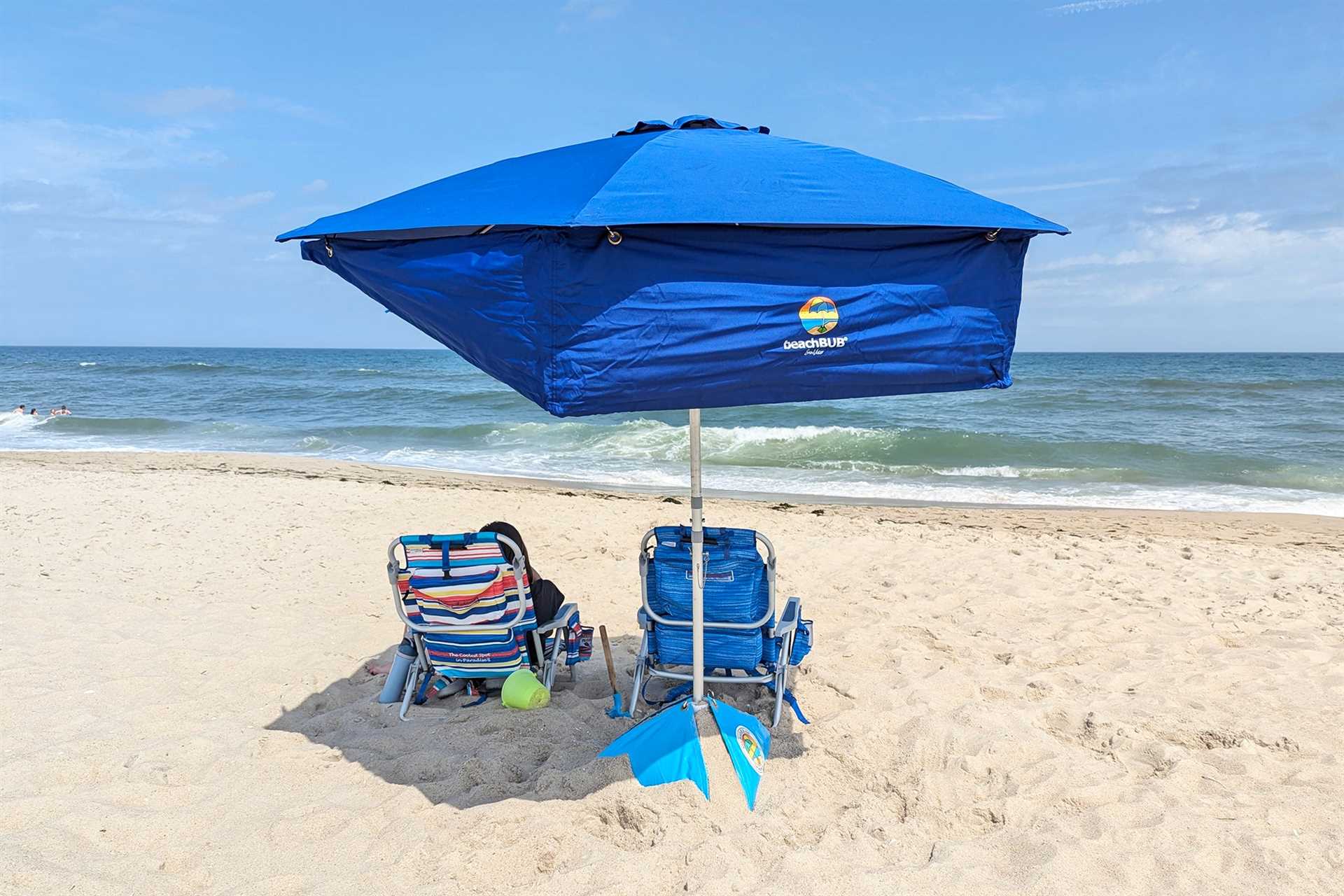


For a hassle-free outdoor experience, selecting the right shade canopy is key. This article provides a detailed guide on various options available, helping you make an informed choice that suits your needs.
You’ll find tips on size, material, and design, ensuring you pick a product that offers both comfort and protection from the sun. Along with practical advice, I’ll share insights on setup and maintenance, making your time under the sun enjoyable.
This guide is perfect for families planning a day by the water, outdoor enthusiasts, or anyone looking to enhance their leisure time in open spaces. By the end, you’ll have the knowledge to confidently select a shade solution that fits your lifestyle and preferences.
Best Beach Canopy Guidelines
Choose a suitable location with enough space and minimal obstructions. Ensure the ground is firm for stability and avoid placing it too close to water.
Before setting up, check the weather conditions. Wind can affect the stability of your canopy, so it’s advisable to avoid windy days. If conditions seem unfavorable, consider postponing your outing.
Assembly Steps
Follow these steps for effective setup:
- Unpack the canopy and lay out all components.
- Assemble the pole sections according to the manufacturer’s guidelines.
- Insert the pole securely into the ground, angling it slightly for added support.
- Attach the fabric to the pole, ensuring it is evenly stretched.
- Use any provided pegs or sandbags to anchor the base, particularly on windy days.
After setup, regularly check the stability of the structure. If you notice any signs of weakness, reinforce it immediately.
Maintenance Tips
Proper care extends the life of your canopy:
- Clean the fabric periodically with mild soap and water.
- Store it in a dry place to prevent mold and mildew.
- Avoid using it during severe weather conditions.
Following these guidelines ensures a reliable and enjoyable experience. Stay safe and prepared for your outdoor activities.
Choosing the Right Size and Material for Your Beach Canopy
The size of your shade structure greatly impacts its effectiveness and usability. A model with a diameter of at least 6 to 8 feet typically provides sufficient coverage for two to four people. For larger groups or families, consider a shade option that spans 9 to 11 feet. This ensures ample protection from direct sunlight and enhances your outdoor experience.
Material selection is equally significant. Look for models made from UV-resistant fabric, which blocks harmful rays and maintains durability. Polyester and nylon are common choices, but those with a UPF (Ultraviolet Protection Factor) rating offer superior sun protection. Additionally, a sturdy frame made from aluminum or fiberglass increases stability, particularly in windy conditions.
Factors to Consider
- Portability: Lightweight materials make transport easier, especially for beach trips.
- Setup: Models with a simple assembly process save time and hassle.
- Wind Resistance: Look for options with a vented design to reduce the risk of flipping in strong gusts.
In summary, prioritize size and material when selecting your sunshade. A well-chosen canopy not only enhances comfort but also ensures safety from sun exposure.
Step-by-Step Guide to Setting Up Your Beach Canopy
Choose a location that offers sufficient shade and protection from the wind. Look for a spot with soft sand to make anchoring easier, and ensure that it’s free from obstructions such as rocks or debris.
Gather all necessary components: the canopy, the pole, and any anchoring tools such as sandbags or stakes. Ensure everything is in good condition and ready for assembly.
Assembly Process
- Insert the Pole: Take the main pole and insert it into the designated holder at the base of the canopy.
- Secure the Canopy: Open the canopy fully by spreading its arms outwards. Make sure it is completely extended to provide adequate coverage.
- Anchor the Base: Use sandbags or stakes to secure the pole in place. If using sandbags, fill them with sand and place them around the base of the pole.
- Adjust the Tilt: If your canopy has a tilt feature, adjust it to angle the top towards the sun’s position. This will enhance shade coverage.
- Check Stability: Gently pull on the canopy to ensure it is securely anchored. Make adjustments as needed.
After setup, periodically check for any shifting due to wind or movement. Reinforce the base if necessary to maintain safety and stability.
Effective Techniques for Securing Your Umbrella Against Wind
To keep your sunshade stable, consider using a weighted base. Sandbags or water-filled containers can significantly reduce the risk of your sunshade being blown away. Ensure the weight is evenly distributed for maximum stability.
Another strategy involves angling the pole. Positioning the pole towards the wind direction helps redirect airflow, minimizing resistance. Adjust the angle as the wind changes to maintain stability throughout your time outdoors.
Additional Tips for Wind Resistance
Using guy lines can enhance stability. Attach these lines to the top of the pole and secure them to the ground with stakes. This creates additional support against gusts.
- Choose a location with natural windbreaks, such as dunes or trees, to shield your setup.
- Regularly check the weather conditions to anticipate wind changes.
- Consider using an umbrella designed for windy conditions, featuring a vented canopy that allows wind to pass through.
Lastly, always monitor your surroundings. If the wind picks up, be ready to take down the sunshade promptly to avoid damage or injury.
Maintenance Tips for Prolonging the Life of Your Canopy
To maintain your shelter in optimal condition, regular cleaning is essential. Rinse the fabric with fresh water after each use to remove sand and salt, which can degrade the material over time. Use a mild soap and a soft brush for deeper cleaning to prevent mold and mildew buildup.
Storage is equally important. Always ensure that your sunshade is completely dry before folding and storing it away. This prevents moisture from causing damage. Use a protective cover during off-seasons or when not in use to shield it from dust and UV exposure.
Additional Care Recommendations
- Avoid High Winds: Set up your shelter in calm conditions to prevent damage from strong gusts.
- Check for Damage: Regularly inspect the ribs and fabric for tears or wear, and repair them immediately.
- Use Weights: Consider using weights or sandbags on the base to enhance stability.
- Keep Away from Heat: Avoid placing near campfires or grills to prevent fabric melting.
- Store Properly: Use a designated bag or storage solution to prevent crushing or bending of the frame.
By following these maintenance strategies, you can significantly extend the lifespan of your outdoor shade solution, ensuring many enjoyable outings ahead.
Best beach umbrella instructions
Features
| Part Number | beachBUB ™ Beach Umbrella System |
| Model | beachBUB TM Beach Umbrella System |
| Warranty | 3 year beachBUB Protection Plan against loss, incidental damage and theft. 3 year frame warranty, lifetime warranty on beachBUB Base Tarp |
| Color | Deep Ocean Blue |
| Size | 7.5 inch |
Features
| Part Number | 1 |
| Model | Beach Cabana - 002 |
| Color | Navy Blue |
Video:
FAQ:
What materials are best for beach umbrellas?
Beach umbrellas are typically made from a variety of materials, each offering different benefits. The canopy fabric should ideally be UV-resistant to protect against harmful sun rays. Common materials include polyester and acrylic, which offer durability and UV protection. The frame is often made from aluminum or fiberglass, which are lightweight yet sturdy. When choosing a beach umbrella, consider materials that can withstand wind and sand exposure while providing adequate shade.
How do you properly set up a beach umbrella?
To set up a beach umbrella, first choose a location that is free from obstacles and has a stable surface. Start by inserting the pole into the sand at a 45-degree angle for better stability. If the umbrella has a sand anchor, use it to secure the pole further by twisting it into the sand. Open the umbrella fully, ensuring that it locks in place. If it’s windy, consider tilting the umbrella slightly into the wind for better stability. Always ensure that the umbrella is firmly anchored to avoid it being blown away.
What size beach umbrella should I choose for my family?
The size of the beach umbrella you choose should depend on the number of people you want to accommodate. For a small family of two to four, a 6 to 7-foot umbrella is generally sufficient, providing enough shade without being too cumbersome. For larger groups or families of four to six, consider an 8 to 9-foot umbrella. If you often go to the beach with a big group, a 10-foot umbrella might be ideal. Additionally, think about how much space you want for beach chairs or other items under the umbrella. Keep in mind that larger umbrellas may require more effort to set up and secure properly.







